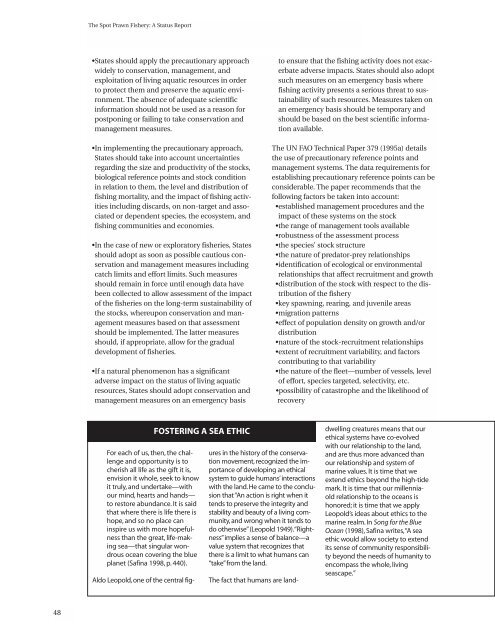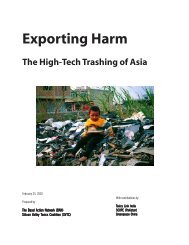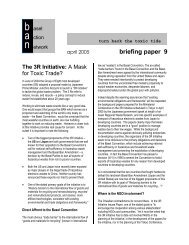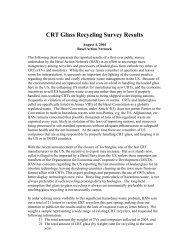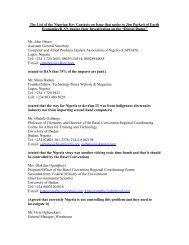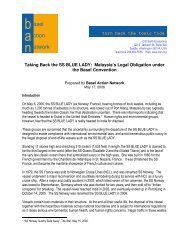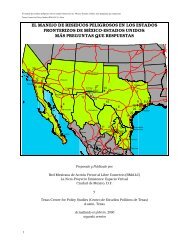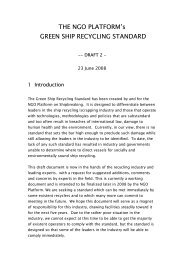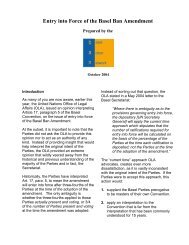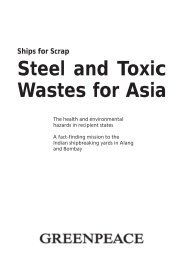The Spot Prawn Fishery The Spot Prawn Fishery - Basel Action ...
The Spot Prawn Fishery The Spot Prawn Fishery - Basel Action ...
The Spot Prawn Fishery The Spot Prawn Fishery - Basel Action ...
Create successful ePaper yourself
Turn your PDF publications into a flip-book with our unique Google optimized e-Paper software.
48<br />
<strong>The</strong> <strong>Spot</strong> <strong>Prawn</strong> <strong>Fishery</strong>: A Status Report<br />
•States should apply the precautionary approach<br />
widely to conservation, management, and<br />
exploitation of living aquatic resources in order<br />
to protect them and preserve the aquatic environment.<br />
<strong>The</strong> absence of adequate scientific<br />
information should not be used as a reason for<br />
postponing or failing to take conservation and<br />
management measures.<br />
•In implementing the precautionary approach,<br />
States should take into account uncertainties<br />
regarding the size and productivity of the stocks,<br />
biological reference points and stock condition<br />
in relation to them, the level and distribution of<br />
fishing mortality, and the impact of fishing activities<br />
including discards, on non-target and associated<br />
or dependent species, the ecosystem, and<br />
fishing communities and economies.<br />
•In the case of new or exploratory fisheries, States<br />
should adopt as soon as possible cautious conservation<br />
and management measures including<br />
catch limits and effort limits. Such measures<br />
should remain in force until enough data have<br />
been collected to allow assessment of the impact<br />
of the fisheries on the long-term sustainability of<br />
the stocks, whereupon conservation and management<br />
measures based on that assessment<br />
should be implemented. <strong>The</strong> latter measures<br />
should, if appropriate, allow for the gradual<br />
development of fisheries.<br />
•If a natural phenomenon has a significant<br />
adverse impact on the status of living aquatic<br />
resources, States should adopt conservation and<br />
management measures on an emergency basis<br />
For each of us, then, the challenge<br />
and opportunity is to<br />
cherish all life as the gift it is,<br />
envision it whole, seek to know<br />
it truly, and undertake—with<br />
our mind, hearts and hands—<br />
to restore abundance. It is said<br />
that where there is life there is<br />
hope, and so no place can<br />
inspire us with more hopefulness<br />
than the great, life-making<br />
sea—that singular wondrous<br />
ocean covering the blue<br />
planet (Safina 1998, p. 440).<br />
Aldo Leopold, one of the central fig-<br />
FOSTERING A SEA ETHIC<br />
ures in the history of the conservation<br />
movement, recognized the importance<br />
of developing an ethical<br />
system to guide humans’ interactions<br />
with the land. He came to the conclusion<br />
that “An action is right when it<br />
tends to preserve the integrity and<br />
stability and beauty of a living community,<br />
and wrong when it tends to<br />
do otherwise”(Leopold 1949).“Rightness”implies<br />
a sense of balance—a<br />
value system that recognizes that<br />
there is a limit to what humans can<br />
“take”from the land.<br />
<strong>The</strong> fact that humans are land-<br />
to ensure that the fishing activity does not exacerbate<br />
adverse impacts. States should also adopt<br />
such measures on an emergency basis where<br />
fishing activity presents a serious threat to sustainability<br />
of such resources. Measures taken on<br />
an emergency basis should be temporary and<br />
should be based on the best scientific information<br />
available.<br />
<strong>The</strong> UN FAO Technical Paper 379 (1995a) details<br />
the use of precautionary reference points and<br />
management systems. <strong>The</strong> data requirements for<br />
establishing precautionary reference points can be<br />
considerable. <strong>The</strong> paper recommends that the<br />
following factors be taken into account:<br />
•established management procedures and the<br />
impact of these systems on the stock<br />
•the range of management tools available<br />
•robustness of the assessment process<br />
•the species’ stock structure<br />
•the nature of predator-prey relationships<br />
•identification of ecological or environmental<br />
relationships that affect recruitment and growth<br />
•distribution of the stock with respect to the distribution<br />
of the fishery<br />
•key spawning, rearing, and juvenile areas<br />
•migration patterns<br />
•effect of population density on growth and/or<br />
distribution<br />
•nature of the stock-recruitment relationships<br />
•extent of recruitment variability, and factors<br />
contributing to that variability<br />
•the nature of the fleet—number of vessels, level<br />
of effort, species targeted, selectivity, etc.<br />
•possibility of catastrophe and the likelihood of<br />
recovery<br />
dwelling creatures means that our<br />
ethical systems have co-evolved<br />
with our relationship to the land,<br />
and are thus more advanced than<br />
our relationship and system of<br />
marine values. It is time that we<br />
extend ethics beyond the high-tide<br />
mark. It is time that our millenniaold<br />
relationship to the oceans is<br />
honored; it is time that we apply<br />
Leopold’s ideas about ethics to the<br />
marine realm. In Song for the Blue<br />
Ocean (1998), Safina writes,“A sea<br />
ethic would allow society to extend<br />
its sense of community responsibility<br />
beyond the needs of humanity to<br />
encompass the whole, living<br />
seascape.”


